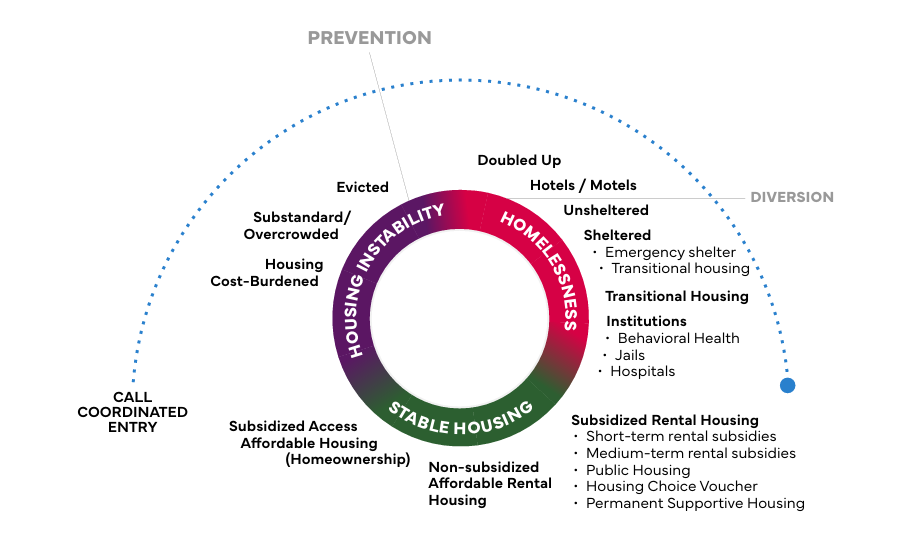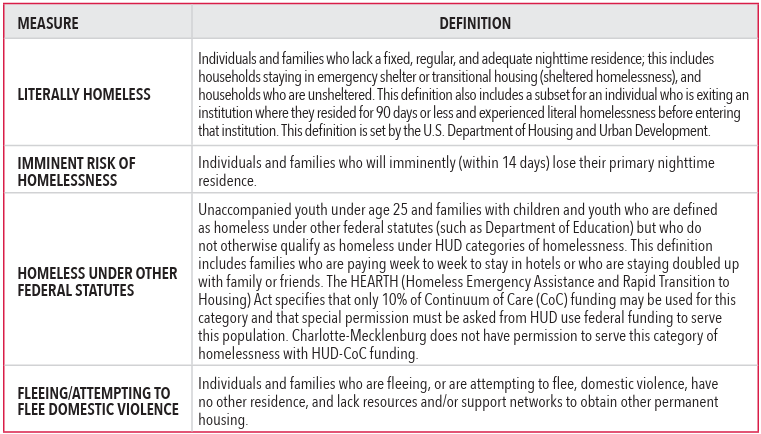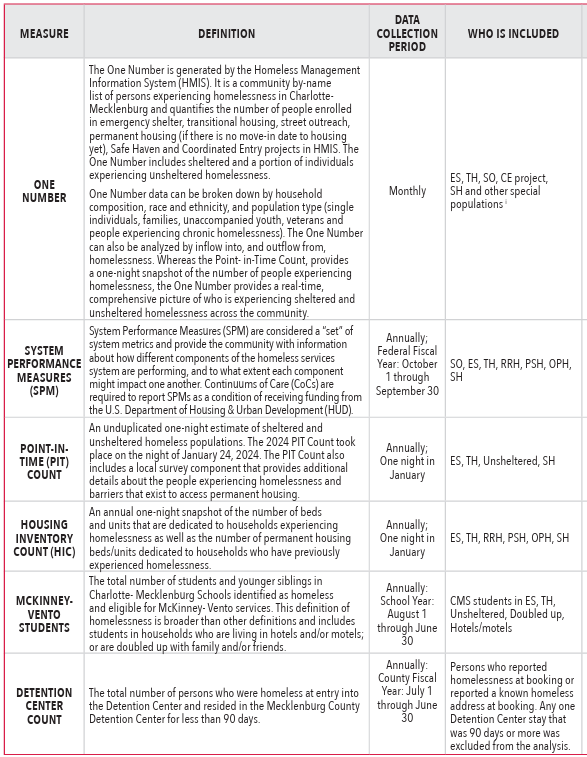2024 STATE OF HOUSING INSTABILITY AND HOMELESSNESS REPORT DEEP DIVE:
Mary Ann Priester
Senior Management Analyst
Mecklenburg County Community Support Services
On January 7, 2025 Mecklenburg County Community Support Services released the 2024 State of Housing Instability and Homelessness report. This annual report compiles the most recent data on housing instability and homelessness for Charlotte-Mecklenburg by synthesizing local, regional, and national data on the full housing continuum (from housing instability to homelessness to stable, permanent, affordable housing). The SOHIH report serves as a knowledge base for all stakeholders to inform policy and practice decisions, optimize resource allocation, plan integrated systems of care, and drive advocacy efforts. The report explores three key components of the housing continuum: housing instability, homelessness, and stable housing. This blog is the first in a series of three blogs will take a deeper dive into each of these components.
This blog post takes a deeper dive into the findings from the second theme: homelessness. It also shares examples of promising practices and what can be done locally to address homelessness.
HOMELESSNESS
Homelessness is defined in a variety of ways. One of the most common definitions is literal homelessness. Literal homelessness, a term coined the U.S. Department of Housing and Urban Development, encompasses both sheltered homelessness (such as those residing in emergency shelters or transitional housing) and unsheltered homelessness. The definition also covers households fleeing domestic violence and individuals living in temporary situations, such as institutions (like detention centers or hospitals) for less than 90 days following a period of homelessness. It’s important to note that definitions of homelessness may vary depending on the funding source providing housing or services. In some cases, households living doubled up with family or friends or those paying week-to-week for hotel or motel stays may be classified as experiencing homelessness.
The SOHIH report focuses on households that meet the definition of literal homelessness meaning their primary residence is either a publicly or privately operated shelter or a location not suitable for human habitation.
MEASURING HOMELESSNESS
The SOHIH uses multiple data sources to illustrate the state of homelessness in Charlotte-Mecklenburg. It highlights six key measures that collectively provide a comprehensive overview of local homelessness. These measures include: the One Number, System Performance Measures (SPMs), the Point-in-Time Count, the Housing Inventory Count (HIC), the McKinney-Vento Students Count, and the Detention Center Count. The One Number represents the total count of individuals and households currently experiencing homelessness, with updates provided monthly. The Point-in-Time (PIT) Count is an annual census conducted in January, capturing the number of individuals experiencing both sheltered and unsheltered homelessness; it often includes an in-depth survey of those who are unsheltered. HUD System Performance Measures comprise a set of metrics that offer a comprehensive understanding of community performance in preventing and addressing homelessness. These measures assess not only progress in reducing the overall number of people experiencing homelessness but also whether the coordinated system effectively ensures that homelessness is rare, brief, and non-recurring. Additionally, the report includes data on students within Charlotte-Mecklenburg Schools who are experiencing housing instability or homelessness, identified as McKinney-Vento students, as well as individuals who spent less than 90 days in the Charlotte-Mecklenburg Detention Center and reported homelessness or a known homeless address upon booking.
WHAT WE KNOW
- As of June 2024, 2,784 people were experiencing homelessness in Mecklenburg County; a 3% increase compared to June 2023.
- 73% identify as Black, African American, or African
- 47% are adults ages 25-54.
- 35% are members of households with minor children; most households with minor children are single female parent households; children aged 0-17 account for 65% of the people in families who are experiencing homelessness.
- 34% of the single people experiencing homelessness are older adults, (age 55 and up).
- The average length of time people experiencing homelessness stay in emergency shelter increased 29% (133 days vs. 103 days) in the past 5 years but the median length of time in shelter has decreased 19% (68 days vs. 55 days).
- Shortages in affordable housing impact the length of time it takes people to exit homelessness.
- Decreases in the median length of time in shelter suggest that overall people are spending less time in shelter and the system is improving at supporting rapid exit from shelter.
- The number of people experiencing homelessness for the first time in 2023 decreased 9%.
- The goal of targeted prevention is to reduce the number of people experiencing first time homelessness.
- These data suggest that the effectiveness of the Continuum of Care’s coordinated prevention system in preventing homelessness.
PROMISING PRACTICES: HOMELESSNESS
Addressing homelessness requires strategies that address the root causes and the immediate needs of households experiencing homelessness. The following are key strategies that can address homelessness:
Housing First Approach: Prioritize access to stable housing without preconditions, such as sobriety or employment and provide access to wraparound services to support households in achieving housing stability.
Increase Employment and Income Support: Opportunities to develop employment skills that facilitate access to living wage employment and investment in staff that can support ease of access to public benefits like unemployment insurance, Social Security, and other financial support are needed to help households exit homelessness and retain housing once they are housed.
Direct Cash Transfers (DCTs): Direct Cash Transfers are an emerging promising practice to improve economic stability and address poverty, housing instability, and homelessness. DCTs have been found to be effective in supporting a household’s rapid exit from homelessness, facilitating the economic empowerment of recipients, improving physical and mental health, and increasing a recipients perceived housing stability.
Homelessness Crisis Response: Expand crisis intervention programs that provide short-term financial assistance, case management, and housing search support to help households rapidly exit homelessness and strengthen prevention and diversion programs that offer alternative solutions to households before they enter shelters.
Cross-Sector Approaches: Ensure interagency and cross-sector collaboration when coordinating services and resources and expand public-private partnerships by engaging corporations and philanthropic organizations in housing solutions, such as funding affordable housing or supporting homelessness prevention initiatives. Together, these strategies can address both the immediate needs of individuals and families as well as the systemic barriers that contribute to homelessness.
WHY DOES THIS MATTER
To effectively address homelessness in Charlotte-Mecklenburg, a coordinated, multifaceted approach is necessary. This approach should integrate affordable housing strategies, robust and flexible financial assistance, and dedicated funding to expand support services in all areas of the homelessness response system from prevention to shelter services to housing. Critical elements include the continued expansion of the housing problem solving intervention; flexible prevention and diversion funding; boosting household income through job programs, cash assistance, and support connecting to cash and non-cash resources; proactively developing partnerships with landlords to encourage acceptance of rental subsidies; and developing more affordable housing units through construction, rehabilitation, and subsidies. Pairing these efforts with comprehensive physical and behavioral health services and strengthened tenant protections to foster stability are essential. By embracing these strategies and ensuring alignment across systems and initiatives, Charlotte-Mecklenburg can work towards making homelessness rare, brief, and non-recurring and ensure everyone in Mecklenburg County has access to safe, permanent, affordable housing.
The 2024 SoHIH report and all complementary material can be found on the Charlotte-Mecklenburg Housing & Homelessness Dashboard https://mecklenburghousingdata.org/state-of-housing-instability-homelessness-reports/
Stay tuned for future blog posts, which will take a deeper dive into the other key findings from the 2024 SoHIH report.




